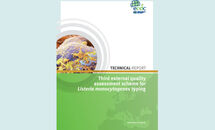Third external quality assessment scheme for Listeria monocytogenes typing
This report presents the results of the third round of the Listeria external quality assessment (EQA) scheme for the typing of Listeria monocytogenes (further EQA-3). The EQA covers the pulsed field gel electrophoresis (PFGE) method, conventional serological typing and PCR-based molecular typing. A total of 22 laboratories registered for participation in the EQA-3 with 20 laboratories completing it and two laboratories opting out without submitting results. The EQA-3 took place between October and December 2014.
Executive Summary
Listeriosis is a relatively rare but serious foodborne disease, and compared with other foodborne diseases caused the most severe cases in humans, with 99% of cases hospitalised.
Since 2007, ECDC has been responsible for the EU-wide surveillance of salmonellosis and listeriosis, and facilitates the detection and investigation of foodborne outbreaks. Surveillance data, including some basic typing parameters for the isolated pathogens, are reported by Member States to the European Surveillance System (TESSy). The molecular surveillance system that has been implemented as part of TESSy relies on the capacity of the laboratories to produce comparable typing results.
Download





